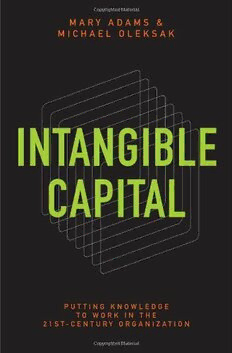
Intangible Capital: Putting Knowledge to Work in the 21st-Century Organization PDF
Preview Intangible Capital: Putting Knowledge to Work in the 21st-Century Organization
INTANGIBLE CAPITAL This page intentionally left blank INTANGIBLE CAPITAL Putting Knowledge to Work in the 21st-Century Organization MARY ADAMS AND MICHAEL OLEKSAK Foreword by Leif Edvinsson Copyright 2010 byMary Adams andMichael Oleksak All rightsreserved. Nopartof thispublication maybe reproduced, stored in aretrieval system, ortransmitted, in anyform or byany means, electronic, mechanical, photocopying, recording, or otherwise, except for theinclusion of brief quotations ina review, withoutprior permission inwriting from thepublisher. Library of Congress Cataloging-in-Publication Data Oleksak, Mary Adams, 1959– Intangible capital :putting knowledge to workin the21st-century organization/MaryAdamsandMichaelOleksak ; forewordbyLeifEdvinsson. p. cm. Includes bibliographical references andindex. ISBN 978-0-313-38074-7 (hard copy : alk. paper)—ISBN 978-0-313- 38075-4 (ebook) 1. Intellectualcapital—Management. I. Oleksak, Michael M.,1957– II.Title. HD53.O44 2010 658.40038—dc22 2010000833 ISBN: 978-0-313-38074-7 EISBN: 978-0-313-38075-4 14 13 12 11 10 1 2 3 4 5 This book isalso availableon the WorldWideWebas an eBook. Visit www.abc-clio.com for details. Praeger An Imprint of ABC-CLIO, LLC ABC-CLIO, LLC 130 Cremona Drive, P.O.Box 1911 Santa Barbara, California 93116-1911 This book isprinted on acid-free paper Manufactured in theUnited Statesof America T his book is dedicated to Harroll H. Adams, an accountant who understood the value of intangibles and who always believed in this endeavor. We wish you were here to share it. This page intentionally left blank c o n t e n t s ForewordbyLeifEdvinsson................................ ix Preface.................................................. xi Introduction............................................ xiii I.THENEWFACTORY................................... 1 1. KnowledgeIstheNewOil ......................... 3 2. IntangiblesAretheNewRawMaterials ............ 19 3. IntangibleCapitalIstheNewFactory.............. 39 II.THENEWMANAGEMENT ........................... 51 4. NetworksAretheNewOrganizationCharts........ 53 5. OrchestrationIstheNewCommandandControl ... 65 6. InnovationIstheNewStrategy.................... 77 III.THENEWACCOUNTING............................ 89 7. IntangibleCapitalExpenditureIstheNewCapital Expenditure..................................... 91 8. AssessmentIstheNewBalanceSheet ............ 107 9. PerformanceMeasurementIstheNewIncome Statement..................................... 123 10. ReputationIstheNewBottomLine.............. 139 Conclusion ............................................ 153 Notes ................................................. 157 Index ................................................. 163 This page intentionally left blank f o r e w o r d In the 1980s, the global economy began to shift dramatically. Fueled by information technology, the investment by the major economies became concentrated in software, process, and knowledge, all considered ‘‘soft’’ and invisible—intangible—in accounting systems. Yet,intangiblesinvestmentisattherootofthegrowthofoureconomies.Ifirst usedtheconceptofintangiblesastherootsofatreeinmy1997bookwithMichael Malone. I continue to use it in my practice of Intellectual Capital Leadership to expressthatintangibles,althoughinvisible,providethefoundationfortherestof theorganizationinthe21stcentury—andfuelcorporateearnings.Thetreeandthe Legosthattheauthorsuseinthisbookarerepresentationsoftheholisticperspec- tivethatisnecessaryforunderstandingtheecosystemofintangiblecapital(IC). Beginning in the 1990s, there has been a greater effort in many countries at makingtherootsofoureconomy—intangibles—visiblebycreatingICreporting. TheWissenbilanzinGermany,RICARDISandInCaSbytheEU,workbyMETI inJapan,andeffortsinHongKongandChinahaveallendeavoredtospreadthe promiseofICasawayofempoweringcompaniestouseintangiblestofuelinnova- tion. Broad partnerships represented by the World Intellectual Capital Initiative (WICI)haveunitedthepublicandprivatesectorsonresearchanddevelopmentof newintangiblesstandards.AlthoughrepresentedinWICI,theUnitedStateshas notdevelopeditsownapproachtointangiblestodate. Despite all these efforts and the great progress by interested academics and business and government leaders, the ideas and the power of IC has not yet moved into the business mainstream. That is why I am very heartened by this new work from Mary Adams and Michael Oleksak. This book is a pio- neering work with an innovative way of explaining IC. It is excellent reading material with illustrative learning cases. The focus on monetization of knowl- edge products and services is very inspiring. The worksheets at the end of each chapter are a very practicable approach. It has a good theoretical base, building on the work of Professor Paul Romer and the New Growth Theory. The book has many helpful distinctions on human capital, relational capital, and organizational structural capital, as well as intellectual property. I can strongly recommend this for not only reading but also application. It is timely and interesting for business as well as the G 20 leaders as we move out of the global recession. Leif Edvinsson The World’s First Director of Intellectual Capital The World’s First Professor of Intellectual Capital
